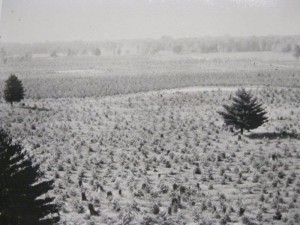Pope Francis’ Laudato si’ speaks to Simcoe County

By John Bacher Springwater Park Citizens Coalition
In his Encyclical Letter, Laudato si’, (On Care for Our Common Home), the Holy Father Francis has made an urgent call for humanity to reverse the process where, “The earth, our home, is beginning to look more and more like an immense pile of filth.” To realize Francis’ vision of a healed global ecosystem, it is important to look at what we can do in our own communities. Few places on the planet speak so immediately to his plea for action as Simcoe County.
Springwater Park 1922
One of the most vivid but disagreeable aspects of the history of Simcoe County is how quickly a landscape dominated by lush forests of towering pines was transformed into a desert. This took place with as astonishing speed between 1830 and 1900 when native peoples lost control over this territory.
In Laudato si’, Francis stresses the role of indigenous people and their role in protecting the earth, so recently happily demonstrated in the Ojibway occupation that rescued Springwater Provincial Park. He notes that for these peoples, “land is not considered a commodity but rather a gift from God and from their ancestors who rest there, a sacred space with they need to interact if they are to maintain their identity and values. When they remain on their land, they themselves care for it best.”
Springwater Park rescued by the Ojibway was itself created as a demonstration site of what could be done to reverse the brutal consequences of Euro-Canadian occupation of the land that created widespread deserts. Its creation was the work of the provincial Premier, E. C. Drury and Edmund Zavitz after they toured the region’s bleak deserts. They were amazed to see in the desert water surging forth from a spring and realized that this area, the headwaters of the Nottawasaga river was an excellent place for a tree nursery.
In their horse and buggy tour of the wastelands created from massive forest fires that sought to clear land for farming and destructive logging, Drury and Zavitz might have felt the same agony as expressed in one of the most eloquent passages of Laudato si’. This is that, “God has joined us so closely to the world around us that we can feel the desertification of the soil almost as a physical ailment, and the extinction of species as a painful disfigurement.”
The accomplishments of Drury and Zavitz are also well commended in Laudato si’. Francis in point 58 of the Encyclical Letter, notes that, “In some countries, there are positive examples of environmental improvement: rivers, polluted for decades, have been cleaned up; native woodlands have been restored; landscapes have been beautified thanks to environmental restoration projects”
Francis sees past restoration efforts such as the greening of the deserts of Simcoe County as proof that “men and women are still capable of intervening positively.” He sees that, ‘For all our limitations, gestures of generosity, solidarity and care cannot but well up within us, since we were made for love.”
It is the challenge of he current generation of residents of Simcoe County to show that they are still as Francis puts it “capable of intervening positively.” To do this we need to show the threats to this positively legacy-massive urban sprawl and clear cutting of forests through by-law suspensions, can be stopped.
John Bacher is author, lecturer and environmental expert witness. His latest book is Two Billion Trees and Counting: The Legacy of Edmund Zavitz, Dundurn Press, 2011. Bacher can be reached at JohnBacherPhD.ca.










Beautiful piece!